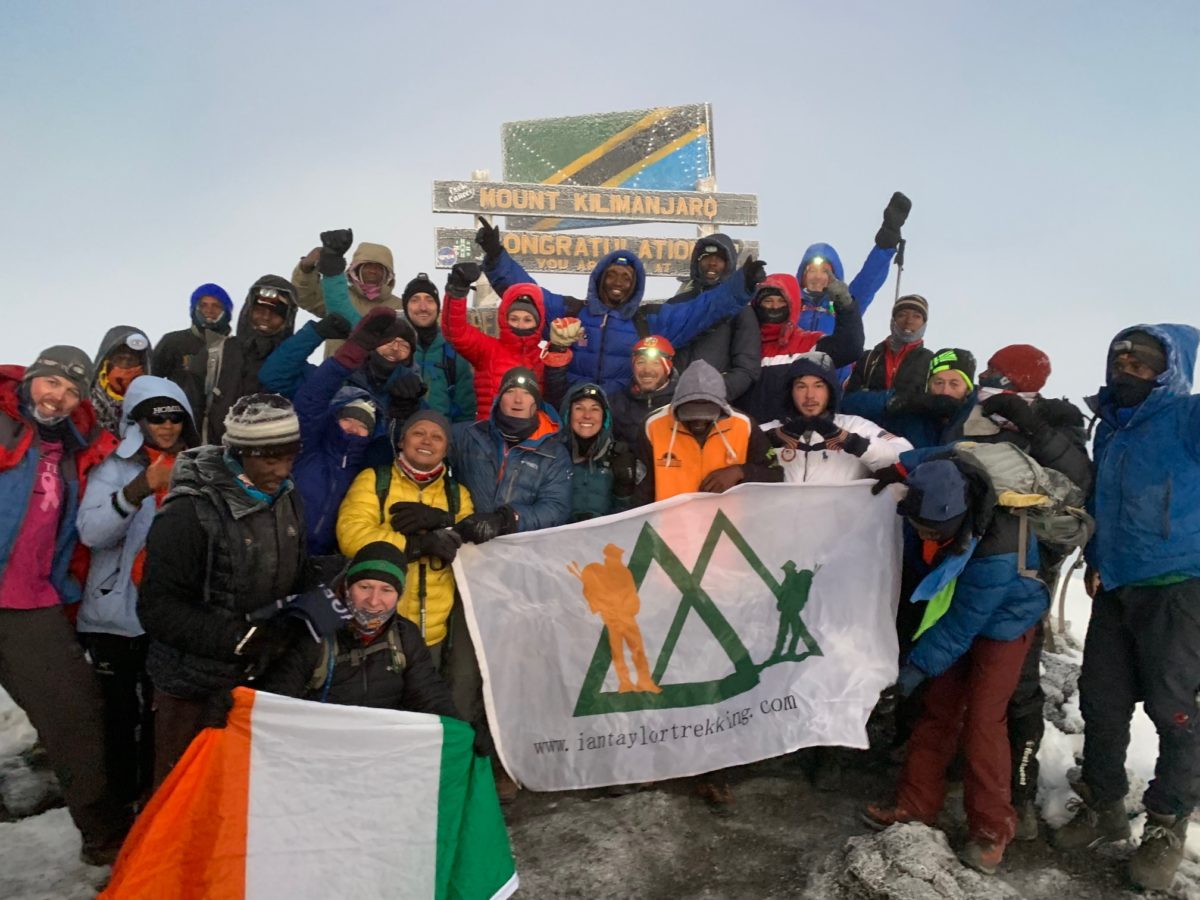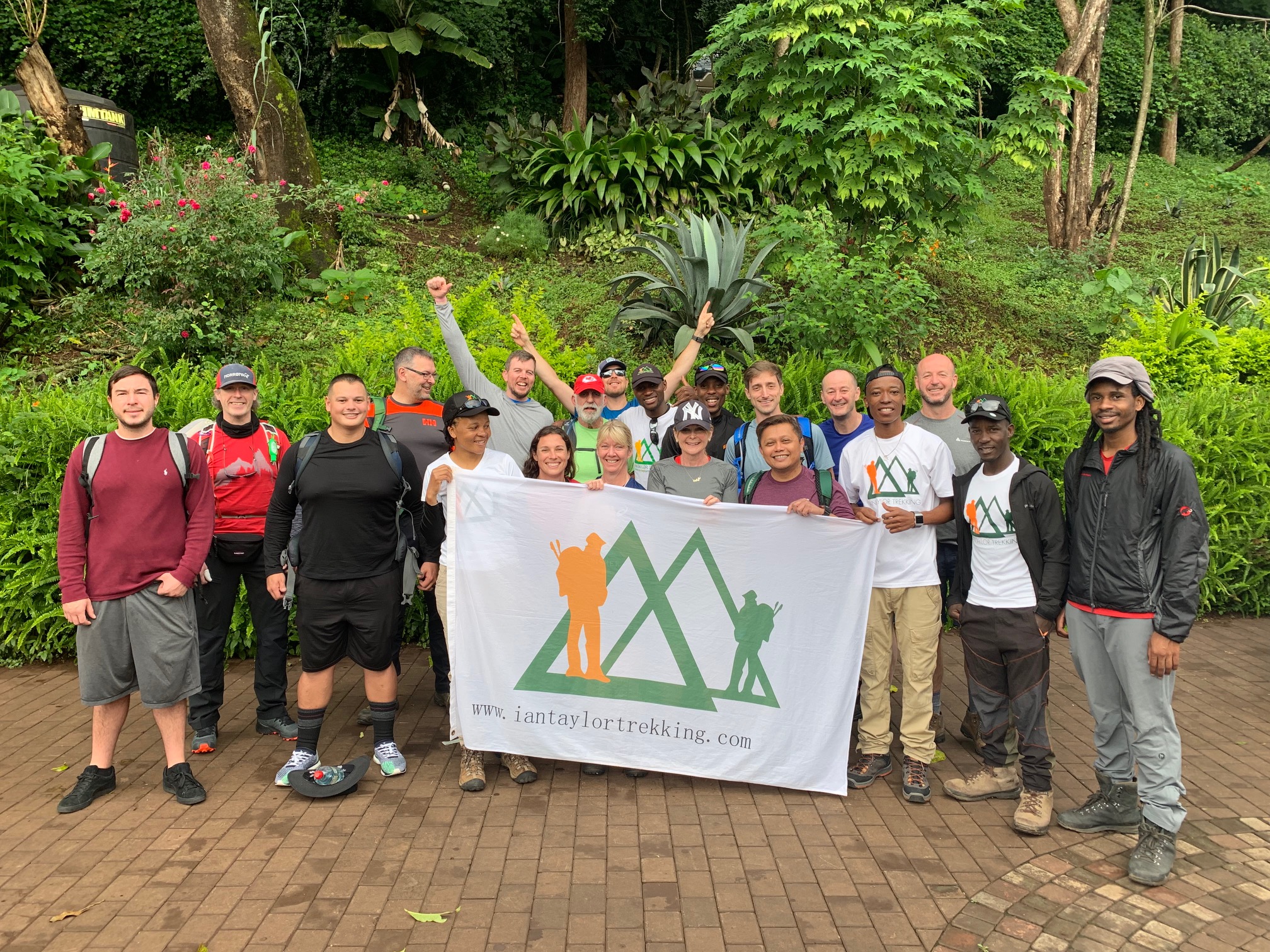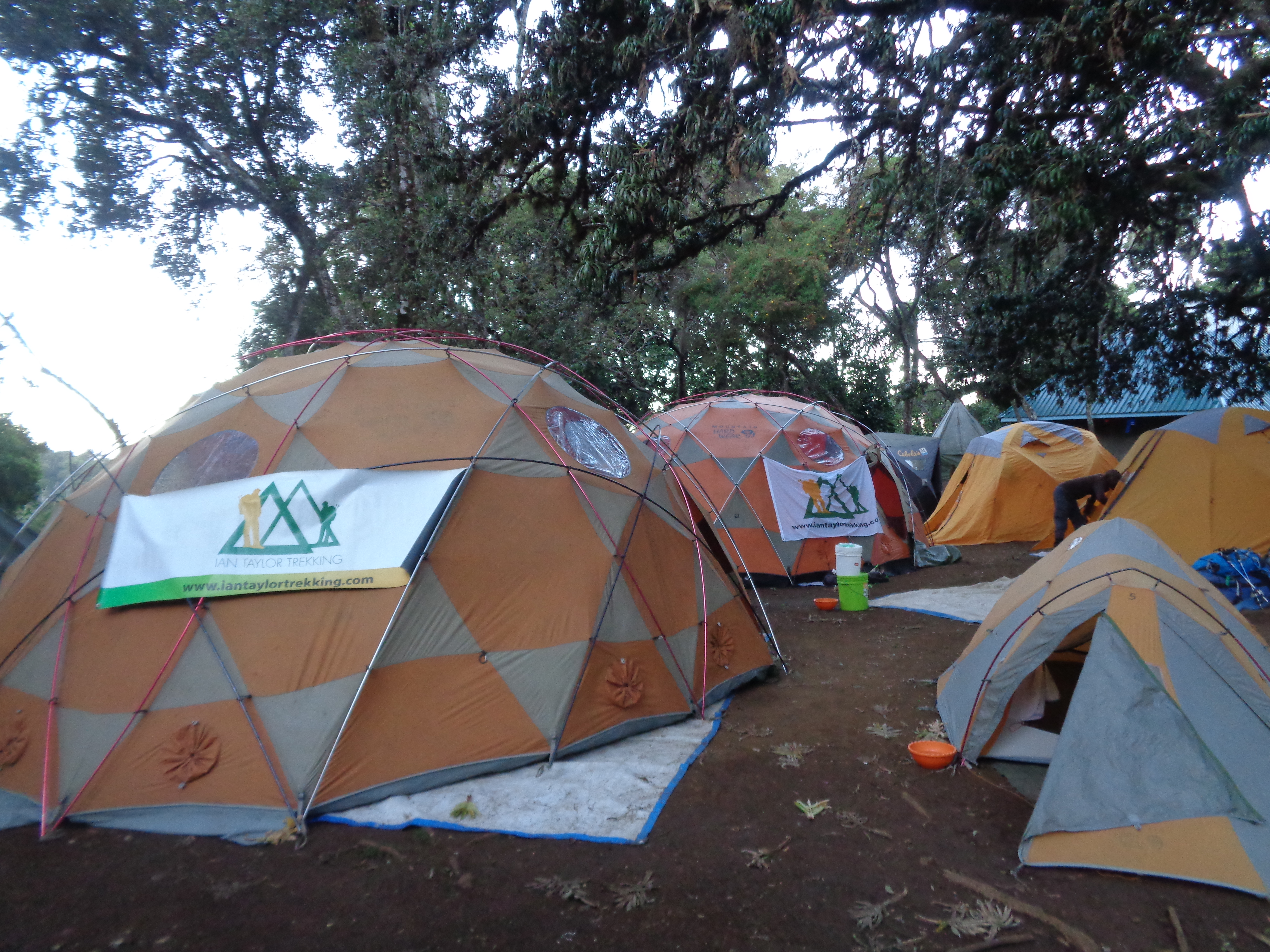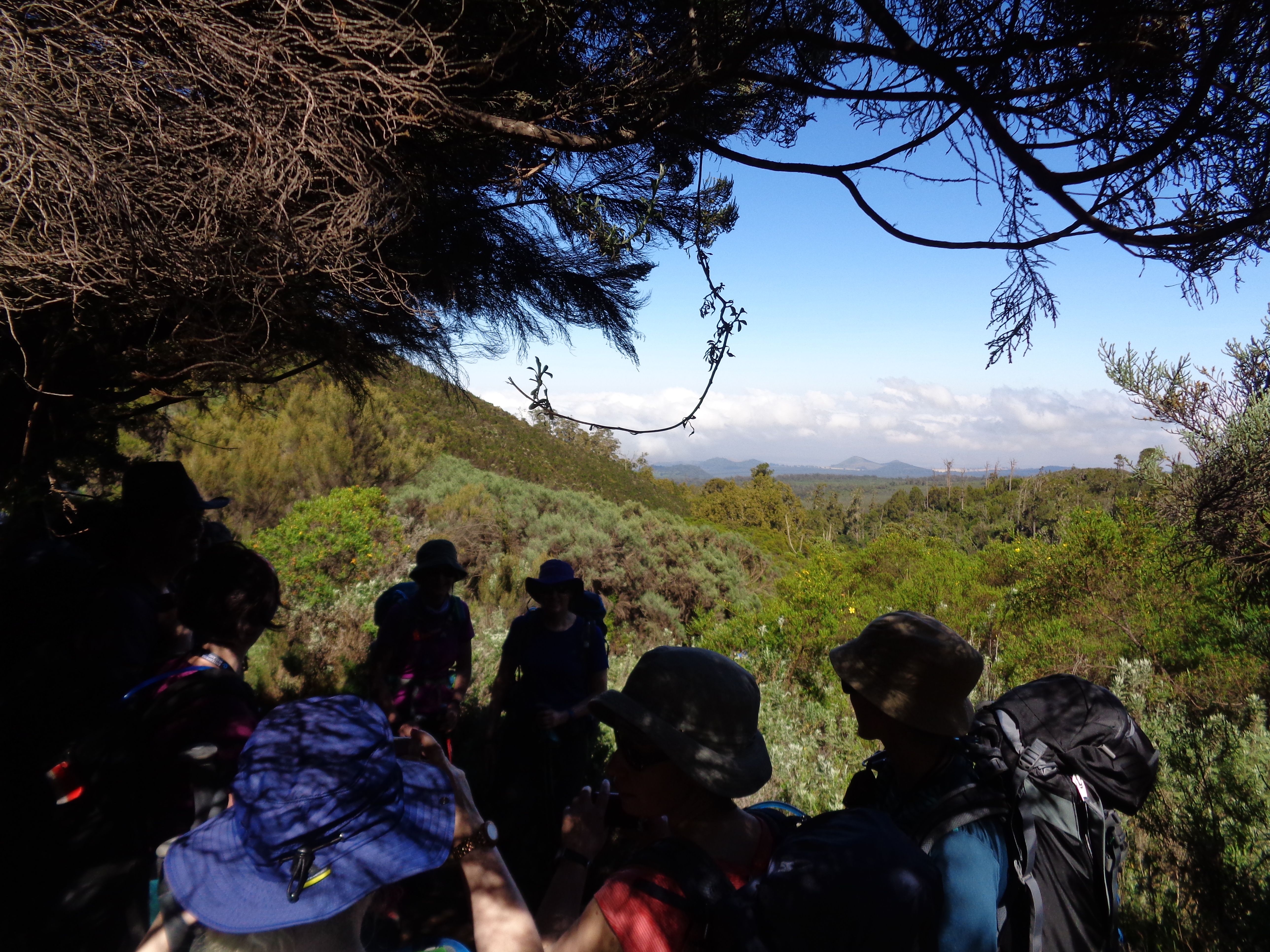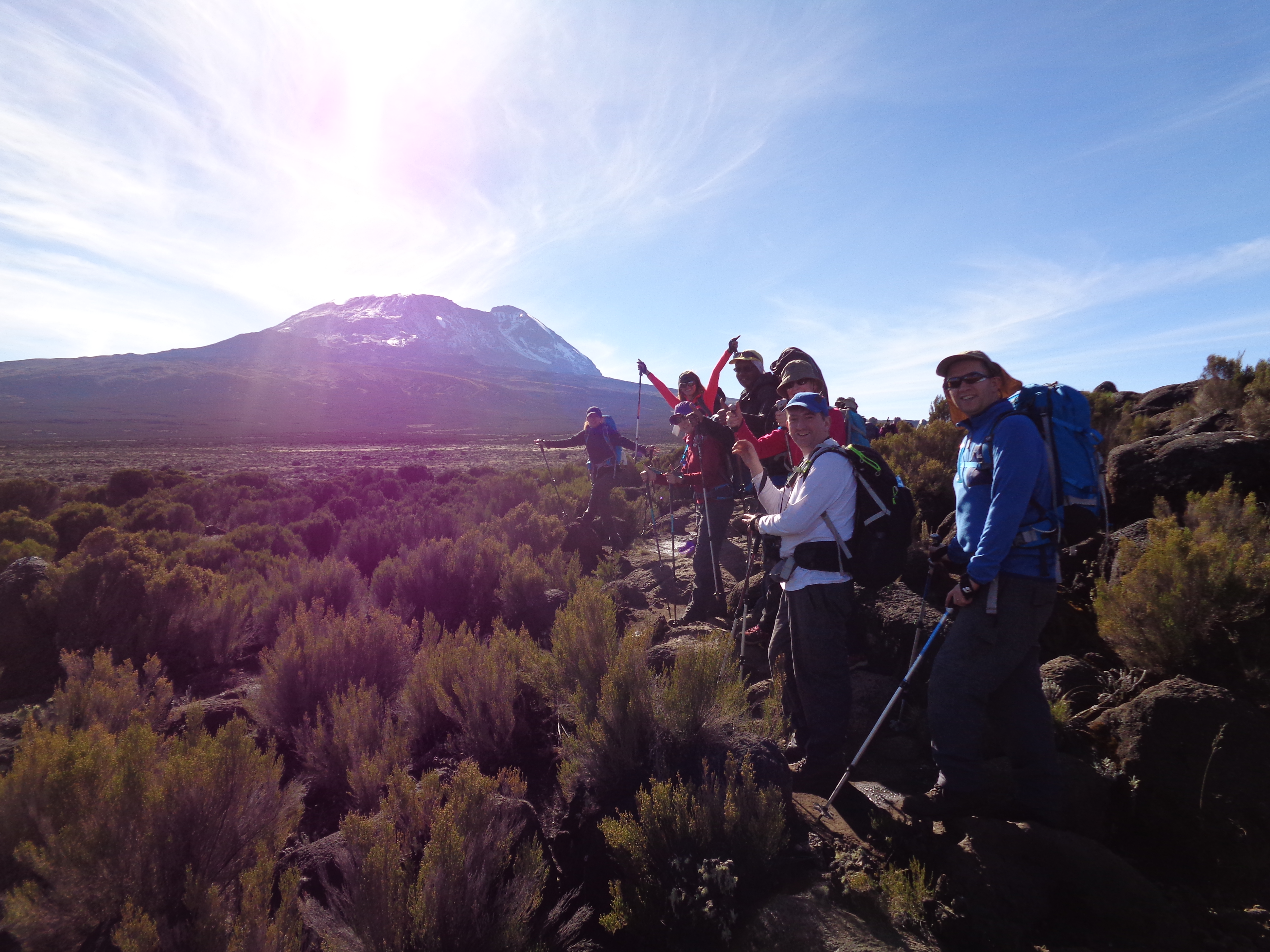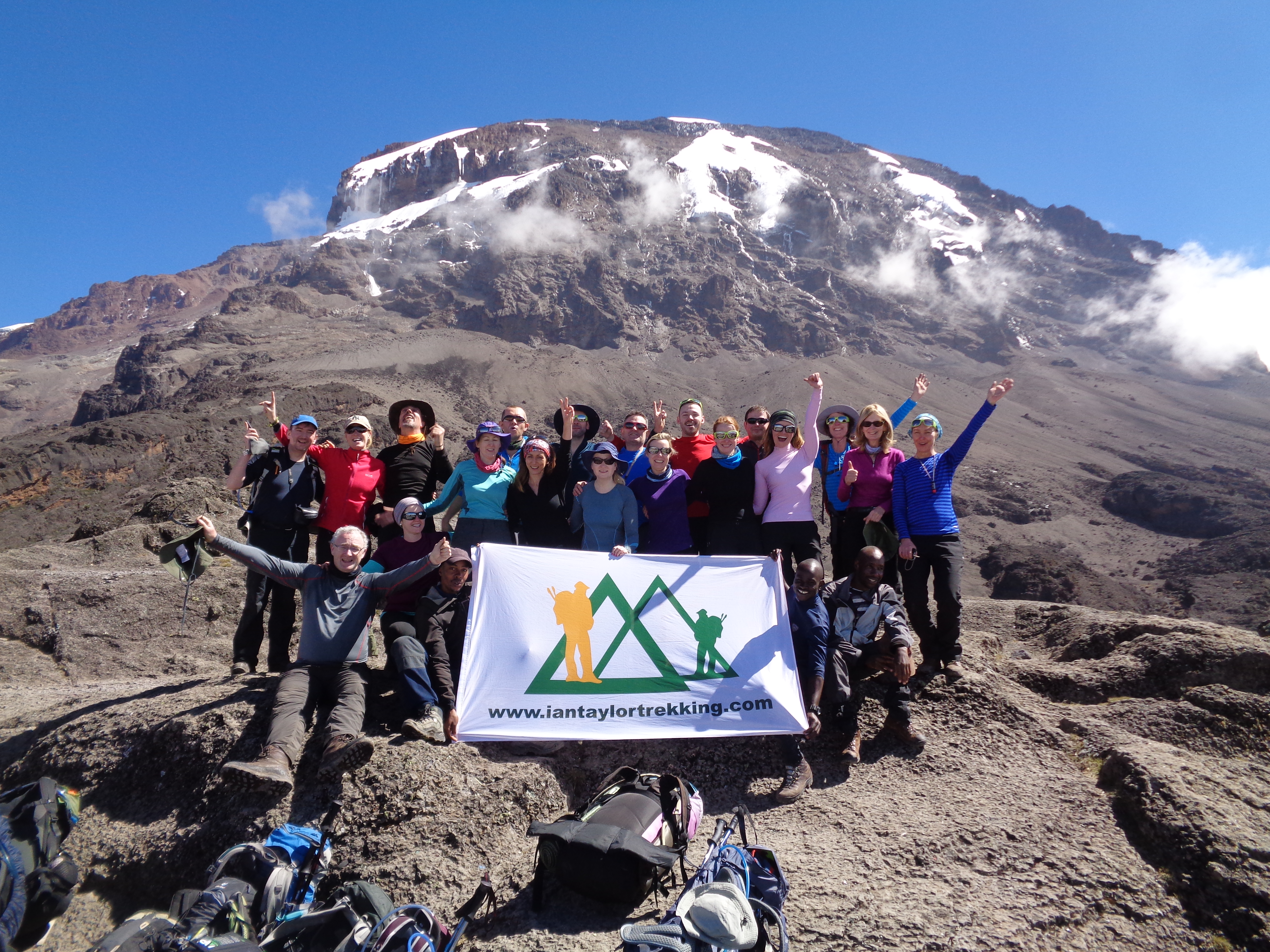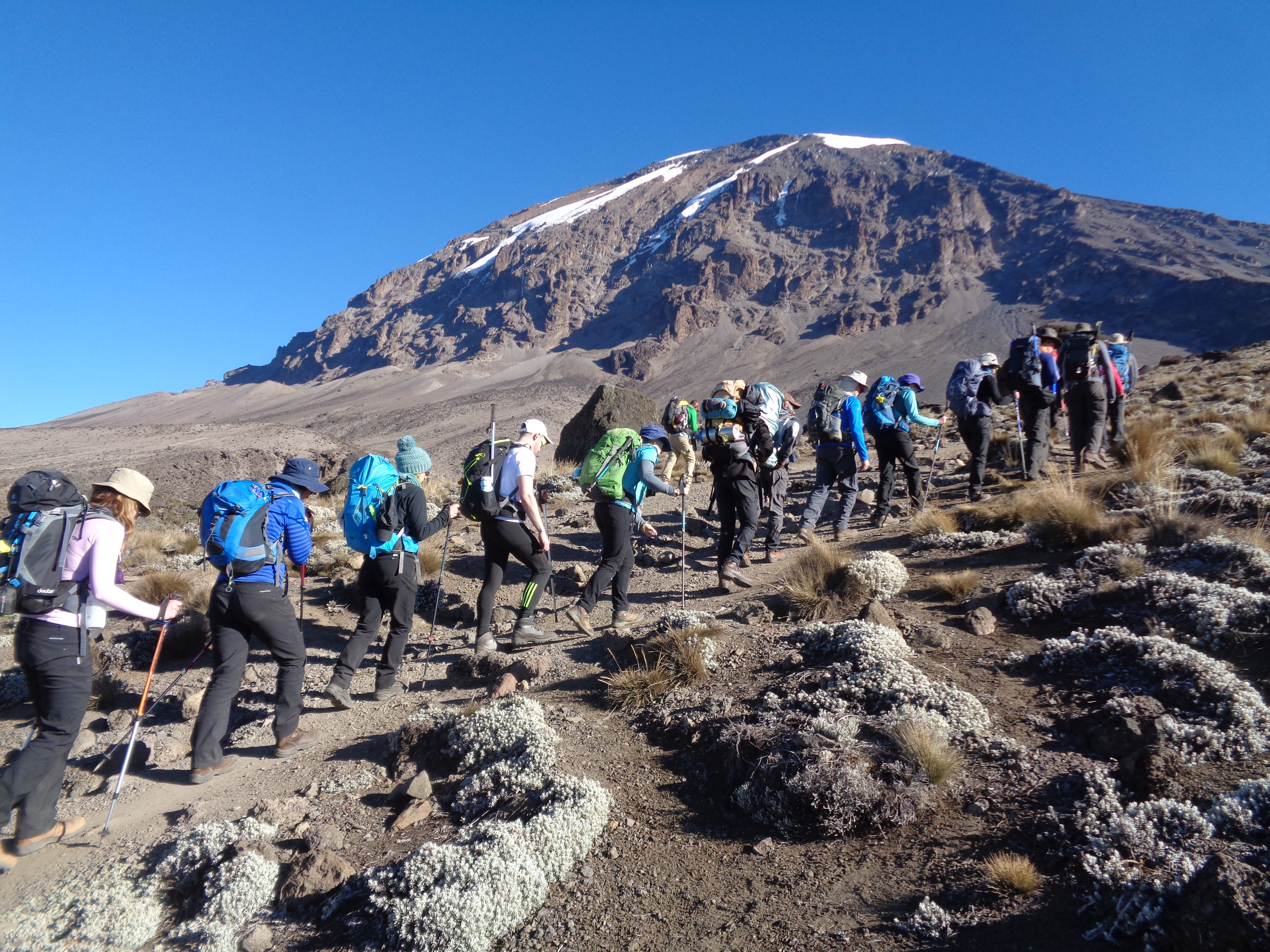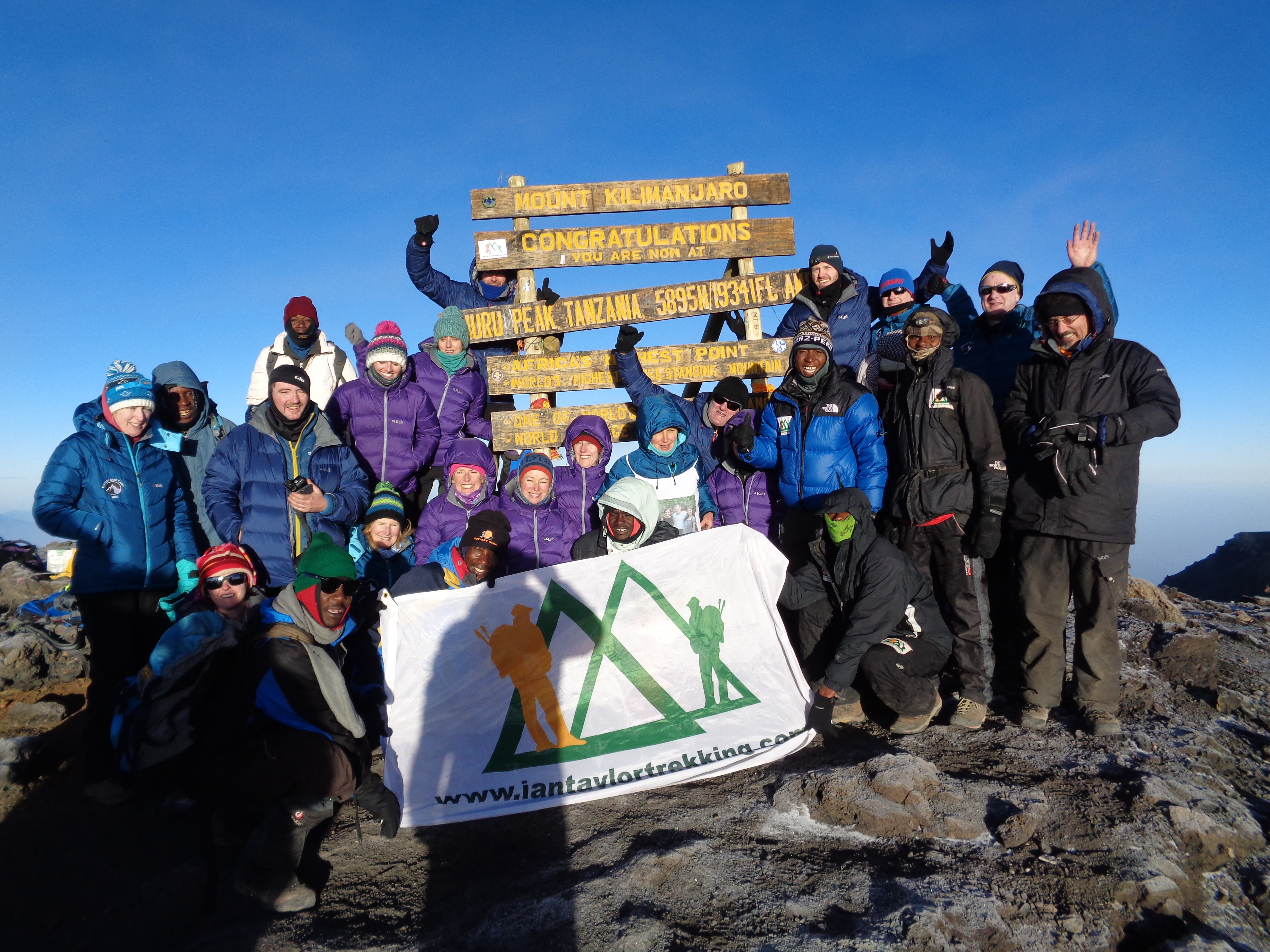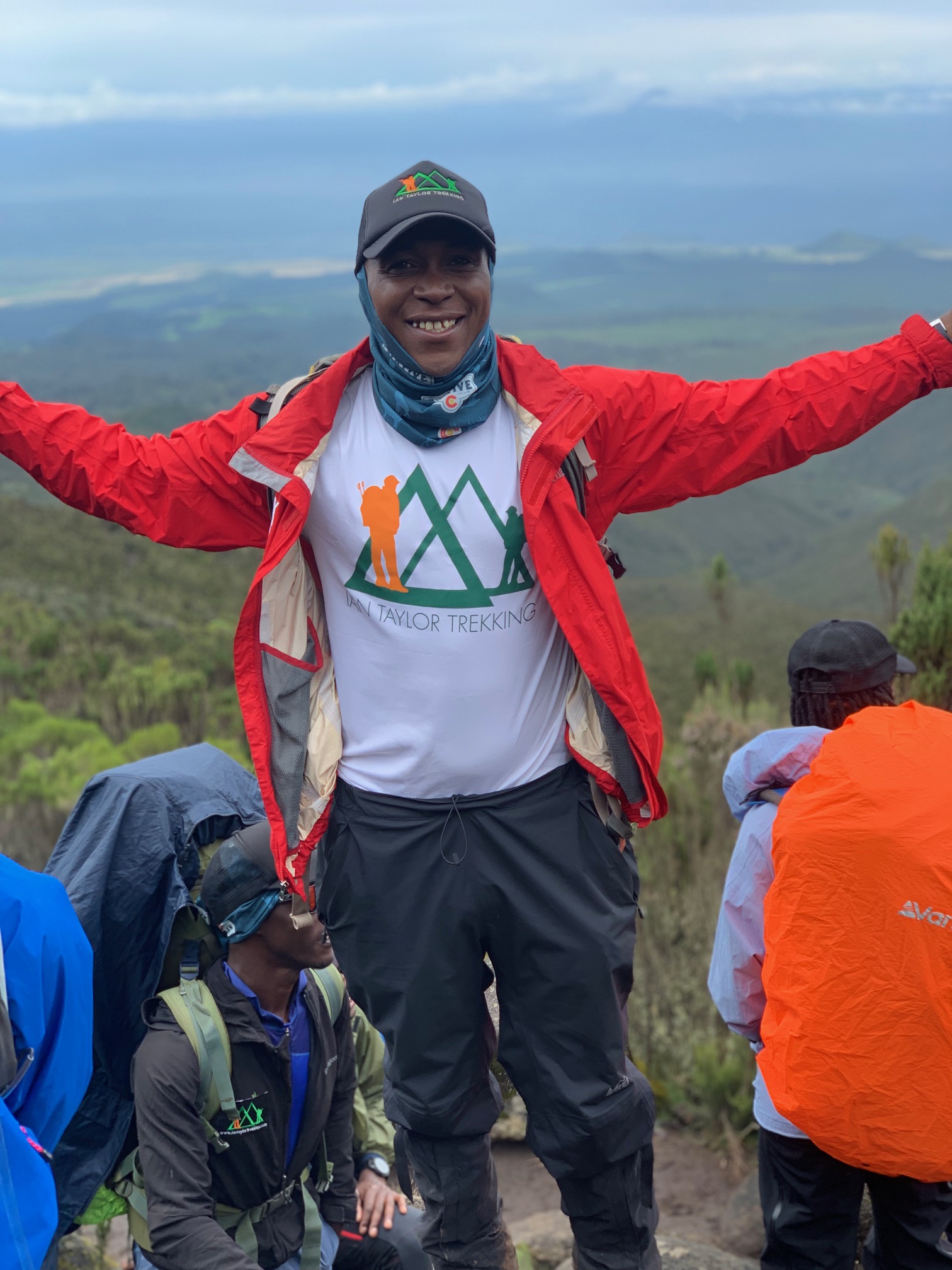Daily distances traveled on the Lemosho Route up Kilimanjaro may differ from each other. It is because not every route to climb Kilimanjaro is the same. We have developed our own itinerary with a high summit success rate.
Ian Taylor Trekking runs over 30 trips per year on this route with a 95% percent Kilimanjaro summit success rate with our clients. 100% on most trips. We also have Kilimanjaro’s Number 1 Guide working for us.
The Best Kilimanjaro Route – The Lemosho Route
We have helped over 3,000 people on the best Kilimanjaro routes to reach the summit, mostly via the Lemosho Route, over 8 days. Eight days on the Lemosho Route gives you the best chance of making the summit of Kilimanjaro. Join our expert team of guides, office staff, assistant guides, porters, cooks and tent crew, to get you up the mountain.
If you want to have the best chance of a safe and successful ascent of Africa’s Highest Peak, then choose Ian Taylor Trekking for your adventure! We do not outsource any of our trips and everyone on our team works directly with us, thus giving you the best experience on the preferred route.
Daily Distances Traveled on the Lemosho Route to Climb Kilimanjaro
If you are signed up for one of our trips you can get access to our staff 5 days a week prior to the trip. You can ask questions about training, gear and ask any questions you may have. CONTACT US for further information on our trips. Also, if you sign up for our trip, then we will send you a 40+ page Dossier with all the information on your trek to Kilimanjaro!
Day 1). Sheraton Hotel to Big Tree Camp
We use the Four Points Sheraton Hotel in Arusha, which sits at 1,400m/4,593 feet above sea level. From here, you have a 4 hour drive to the Lemosho Gate at 2,300m/ 7,546 feet, which is where you check into the Kilimanjaro National Park. The team will aim to arrive at the gate by noon and have a hot lunch while all the gear and food are divided among the porters, for them to carry up the mountain.
For each group of approximately 10 trekkers, we will provide around 60 staff members, experienced in working on Kilimanjaro routes. Our team consists of guides and their assistants, chefs, porters, tent crew, security workers, chefs, and runners who deliver fresh food up the mountain on the whole Kilimanjaro route.
Finally, it is time to start hiking! From the lunch spot, it takes 3 hours of slow hiking to get to Big Tree camp and is a total of 3.7 miles/ 6km. The elevation gain is 500m/ 1,640 feet.
On this day, you will be able to get used to the lower oxygen levels and let your body adjust properly in this initial stage of climbing Mount Kilimanjaro. As the trail leads through the Rain Forest, you may have the opportunity to observe some amazing wildlife living in this part of the Kilimanjaro route.
However, keep in mind that this trail leads steadily uphill through potentially slick terrain. For this reason, you need to be very careful and take slow and secure steps.
Read more on Day 1 on the Lemosho Route.
Day 2). Big Tree Camp to Shira Camp 1
The routine on most days on the mountain will be to wake at 6 am, have breakfast at 7 am and then leave the camp by 8 am. Once you leave Big Tree Camp, you will continue through the beautiful Rainforest. At 3,000m/ 10,000 feet, you exit the dense rainforest and are treated to some amazing views out across the western side of Mount Kilimanjaro.
After a nice hot lunch, the trail heads straight up to the rim of the Shira Plateau before dropping down to Shira Camp 1 at 3,500m/ 11,483 feet. This will take approximately 6 hours with plenty of breaks and a 3-course lunch along the way to facilitate moving into higher altitude.
There will be no rush – we will give you a lot of time to rest and admire the views during lunch. However, you need to be cautious because as the trail goes uphill, it becomes steeper.
Be prepared that the second day of this Kilimanjaro route can be pretty challenging but very rewarding. The weather may be unpredictable, so you should remember to take all the necessary gear with you. You will need protection against the rain, but also the sun.
What’s more, you should drink a lot of water – the recommended amount is around 4-5 liters. In this way, you will make it easier for your body to get used to the lower levels of oxygen. But the stunning views visible from there are definitely worth it!
The total distance today is 4.9 miles/ 7.9km. Elevation gain of 700m/ 2,296 feet.
Read more on Day 2 on the Lemosho Route.
Day 3). Shira Camp 1 to Shira Camp 2
Just as yesterday, you will get up at 6 am for a 7 am breakfast and start trekking at 8 am. Today is an easier day on this Kilimanjaro route. We move from Shira Camp 1 to Shira Camp 2 at 3,900m/ 12,795 feet. This is an easier hike and this day gives great acclimatization for climbing Kilimanjaro. You may have been feeling the effects of altitude at Shira Camp 1, but with this extra night at Shira Camp 2, you should be feeling better!
This trek takes about 4 hours and is 6.2 miles/ 10km. The total elevation gain today will be 500m/ 1,640 feet. After lunch and some time to rest, rehydrate or sleep, we also do a short acclimatization hike up to 4,000m/ 13,123 feet, which will take approximately another hour.
Hiking the Shira Plateau will certainly be a pleasant and relaxing experience. Apart from beautiful views, there is also one more advantage – there is a medical evacuation road running across the Shira Plateau between Shira Camp 1 and Shira Camp 2.
As a result, if anyone is not able to climb Kilimanjaro due to altitude sickness or any other health problems, this route descends easily so they can get down the mountain quickly. This is one of the reasons why the Lemosho Route is one of the best Kilimanjaro routes out there.
If you feel well and you want to keep going, you will have a great opportunity to see the three volcanoes that Kilimanjaro consists of – Mawenzi, Shira, and the summit, Kibo. In Shira Camp 2, you will have the chance to admire a beautiful sunset. Moreover, you will also be able to see the Shira Cathedral (a huge rock mass surrounded by high-pointed rocks), the African Plains and Mount Meru (the fifth-highest mountain in Africa) in the distance.
Read more on Day 3 on the Lemosho Route.
Day 4). Shira Camp 2 to Barranco Camp
Today is a longer day, and it will be a good test as you will trek up to the Lava tower, at 4,600m/ 15,092 feet. You will take a very slow pace which helps with adapting to the lack of oxygen. This trek will take approximately 4 hours to reach the high point of the Lava Tower. After a 3 course hot lunch, you will then drop down into Barranco Camp at 3,900m/ 12,795 feet. It is quite an idyllic spot, so you will certainly enjoy spending the night there!
Most people will really feel the altitude this day, and it is quite normal to have a headache, not wanting to eat or feeling nauseous. Therefore, you should have Ibuprofen with you to decrease inflammation on your Mt Kilimanjaro hike. Also, make sure you are well hydrated, as hydration is important at high altitudes.
This day adds excellent acclimatization. In general, a tough day helps you acclimatize and prepare for the challenging summit night to come, so your heart rate should be up and running (but not too much, of course). It is important to prevent lactic acid from pushing into the muscles on that day because it makes you more exhausted and makes it more difficult for you to recover on the routes of Kilimanjaro.
You will be trekking for 7 hours on this day for 6.7 miles/ 10.8km. When you leave Shira Camp 2, you will be climbing quite gradually uphill until getting out of the shrubs and grass. From this moment on, you will be heading towards a low-oxygen environment. What’s more, you will have quite an extraordinary experience hiking with rocks of various sizes thrown out of the volcano on its last eruption.
The elevation gain is 750m/ 2,460 feet up and down 700m/ 2,296 feet. Read more about day 4 on the Lemosho Route.
Day 5). Barranco Camp to Karanga Camp
After a good night’s sleep, you will be up at 6 am for a 7 am breakfast. We have an amazing challenge for you today! We head up the Barranco Wall – check out our YouTube video on the wall. Everyone always says it is easier than they pictured. Climbers call it “a scramble,” which means you don’t have to have advanced climbing skills to traverse this area. Although it shouldn’t present any significant challenge if it turns out too difficult for you, don’t worry – we will have our highly qualified and experienced guides to help you at every turn.
It is also a place where four different Kilimanjaro routes cross – apart from ours, there is also the Shira Route, the Machame Route, and the Umbwe Route. The Barranco Wall emerged as a result of volcanic activity and landslides in the area. It is so high that it’s hard to see the top when you look up from the bottom! It can take a couple of hours to reach the top at 4,200m/ 13,780 feet.
Upon reaching the top, we take a break right under the summit in the distance to let you admire the incredible views. Then, you will continue on easy trails up and down as we cross Kilimanjaro to the Karanga Valley. It is a beautiful place with low-lying land between hills and with a stream flowing through.
Then with the camp in view across the Valley, we drop steeply down 140m/ 460 feet, before coming back up 120m/ 400 feet to the Karanga Camp at 4,050m/ 13,287 feet.
The Kilimanjaro trek today is approximately 4 hours and a nice break from the previous day’s trekking. The total distance made to climb Kilimanjaro today is 3.5 miles/ 5.6km. The wall is an initial steep ascent of 300m/ 984 feet. Descend 140m/ 460 feet down into the Karanga Valley, before going back up 120m/ 400 feet. Read more about Day 5 on the Lemosho Route.
Day 6). Karanga Camp to Kosovo Camp
Today starts the business end of the Lemosho Route, as we head up to our high camp and get ready for the summit attempt. You will leave at 8 am and take your time, walking very slowly and saving all your energy for the final Kilimanjaro climb. You will take lots of breaks on the section and continue to cross around Kilimanjaro before a final steep section to Barafu Camp at 4,650m/ 15,256 feet.
This is where most people stay before their ascent from Mount Kilimanjaro. We move through Barafu Camp and hike an additional hour further to the Kosovo Camp at 4,900m/ 16,076 feet. We will aim to reach the Kosovo Camp at midday. From our experience, we know that this camp provides more acclimatization and helps to increase the success rate.
When we leave the Karanga Camp and move steeply uphill, you will have the opportunity to see the summit glaciers of Kilimanjaro on your left. After the first steep hour, the trail will become more gentle for the next hour and a half.
The walk to Barafu Camp is approximately 3 hours and then another hour to Kosovo Camp, so a total of 4 hours today. The direct route from the Barafu Camp to the Kosovo Camp is quite steep, so prepare for a challenge! We recommend focusing on taking slow and careful steps and remembering to breathe properly.
There should be deep breaths in through your nose and out through your mouth. Take it easy, and don’t use more of your precious energy than necessary – you should save it for the upcoming long summit night!
Staying well-hydrated is significant every day when you climb Kilimanjaro, but it is particularly crucial on that day. Also, it is strongly advised to wear a buff or something similar on your neck/mouth as it will allow you to protect yourself from dust reaching your mouth and help you to keep moisture in it.
The goal will be to be in the Kosovo Camp for a big lunch/ dinner around 2 pm. We encourage you to rest after the meal as you will get up at 11:30 pm to prepare for your summit bid.
Get into your tent early, eat and drink well, and get prepared for the summit, both mentally and physically. It is crucial to pack all the essentials like a sun hat, sunscreen, or sunglasses, as well as to warm your summit clothes up in your sleeping bag.
Today you will walk 3 miles/ 4.8km. The elevation gain to the Kosovo camp is 850m/ 2,789 feet. Read more on Day 6 on the Lemosho Route.
Day 7). Kosovo Camp to the Summit then Down to Mweka Camp
You will wake up at 11:30 pm for a 1 am departure from Kosovo Camp to continue climbing Kilimanjaro on your way to the summit. However, this will depend on the conditions, size of the group and a range of other factors. You should start drinking water (a liter if possible), start eating some food in your tent, and prepare to leave. It will get colder later in the night and if the winds pick up, it can feel very cold.
Remember, tonight is not easy, so when you are mentally struggling, you need to remember to breathe deeply. Incorrect breathing can ruin your summit. Deep breathing in through your nose and out through your mouth, focus on breathing and foot placement and try not to get discouraged.
It normally takes about 6 hours from Kosovo Camp to the Mount Kilimanjaro summit. The last 2 hours to the crater rim will test you, so stay focused and believe you can do it as you are almost there. Don’t rush it up, take your time and let your body properly get used to the low levels of oxygen near the summit to increase the probability you will climb Kilimanjaro successfully.
From Stella Point at the crater rim, it is one hour to the summit on easier terrain. Remember to walk very slowly, particularly when you’re high on the mountain.
Then, you have climbed Kilimanjaro and reached the Roof of Africa!
From the summit back to Kosovo Camp can take 2-3 hours. You will have a chance to rest for a few hours and pack up your duffel bag before having lunch and moving down lower. You will head down to Mweka Camp at 3,100m/ 10,170 feet. This will take 4 hours downhill. Finally, the long day will come to an end!
The full day is 12 – 14 hours of trekking and covers 11.2 miles/ 18.1km. 1,245m/ 4,084 feet up the mountain from Barafu or 1,095m/ 3,592 feet up from Kosovo Camp to the summit. You then have 2,795m/ 9,169 feet downhill, all on the same day. Read more about Day 7 on the Lemosho Route.
Day 8). Mweka Camp to Mweka Gate
After an amazing summit success and a great night’s sleep in Mweka Camp, we will have a quality breakfast before saying goodbye to our world-class Kilimanjaro crew. However, our head guide, who is Kilimanjaro’s Number one Guide, and assistant guides will stay with you all the way until the end. From Mweka Camp to the Mweka Gate takes approximately 4 hours, walking back through the Rain Forest.
Without a doubt, you will want to use your trekking poles to save your knees on the way down from the summit of Kilimanjaro to the gate. The temperatures will be higher, so you can pack away your warm clothes and cold-weather gear. On the last day, you can wear a T-shirt, shorts and a sun hat! However, be prepared for likely rain, and watch your steps as this part of the trail can get quite slippery.
Even if that’s the final stage of the journey, you still need to remember about proper hydration – do not forget to have at least 3 more liters of water to walk down the mountain.
Once you get to the exit gate, you will have the chance to take your last photos on the mountain, and then you need to sign out from the National Park and jump on the bus. The team will drive a few minutes down the road to have lunch.
After lunch, you will have some time for souvenir shopping, and then you will need to get back on the bus and then drive back to our hotel in Arusha. Today is 5.8 miles/ 9.3km. Descend 1,400m/ 4,593 feet. Read more about Day 8 on the Lemosho Route.
FAQ on Climbing Kilimanjaro on the Lemosho Route
1. Is the Lemosho Route the only route to climb Kilimanjaro?
No, there are other Kilimanjaro routes available, including, for example, the Machame Route, the Marangu Route, The northern circuit or the Rongai Route. However, we consider the Lemosho using Kosovo camp to be the best route to climb Kilimanjaro, as, in our opinion, it is the safest, the most enjoyable, and it has the highest summit success rate.
2. Do I need any special training before I climb Kilimanjaro?
As Kilimanjaro is a trekking peak, it does not require any technical training to complete the climb. However, it doesn’t mean you don’t need to prepare in any way. Read more on the training to climb Kilimanjaro here.
3. Why does the journey take as long as 8 days?
Some people prefer to go for a shorter journey to save money and time. However, 5-7 days may not be enough to let your body prepare for the summit, and you may suffer from altitude sickness and not make it to the top. As experienced professionals, we know that 8 days on the Lemosho Route is the most optimum choice.
Speak to the Experts Who Will Take You to The Route on Kilimanjaro
We hope this post about the daily distances traveled on the Lemosho Route up Kilimanjaro was useful. GET IN TOUCH today for more information on our 8 day Kilimanjaro Climbs. We want to make sure that our clients have all the right information to help them prepare for the journey ahead. If you want to have an safe and successful experience on the mountain, then get in touch today! Follow us on Instagram.

